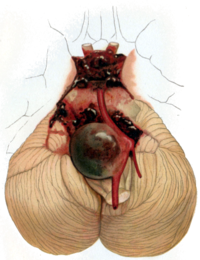
Photo from wikipedia
Background and Purpose Aneurysm wall enhancement (AWE) on vessel wall magnetic resonance imaging has been suggested as a marker of the unstable status of intracranial aneurysm (IA) and may predict… Click to show full abstract
Background and Purpose Aneurysm wall enhancement (AWE) on vessel wall magnetic resonance imaging has been suggested as a marker of the unstable status of intracranial aneurysm (IA) and may predict IA rupture risk. However, the role of abnormal hemodynamics in unruptured IAs with AWE remains poorly understood. This study aimed to determine the association between abnormal hemodynamics and AWE in unruptured middle cerebral artery (MCA) aneurysms. Methods A total of 28 patients with 32 bifurcation aneurysms of the middle cerebral artery>3mm in size were retrospectively selected for this study. Vessel wall magnetic resonance images were reviewed, and the AWE pattern of each aneurysm was classified as no AWE, partial AWE, and circumferential AWE. Computational fluid dynamics were used to calculate the hemodynamic variables of each aneurysm. Univariate and multivariate analyses investigated the association between AWE and hemodynamic variables. Results AWE was present in 13 aneurysms (40.6%), with 7 (21.9%) showing partial AWE and 6 (18.7%) showing circumferential AWE. Kruskal–Wallis H analysis revealed that hemodynamic variables including wall shear stress (WSS), oscillatory shear index, aneurysm pressure (AP), relative residence time, and low shear area (LSA) were significantly associated with AWE (p < 0.05). Further ordinal logistic regression analysis found that WSS was the only factor with a significant association with AWE (p = 0.048); similar trends were identified for LSA (p = 0.055) and AP (p = 0.058). Spearman's correlation analysis showed that AWE was negatively correlated with WSS (rs = −0.622, p < 0.001) and AP (rs = −0.535, p = 0.002) but positively correlated with LSA (rs = 0.774, p < 0.001). Conclusion Low wall shear stress, low aneurysm pressure, and increased low shear area were associated with aneurysm wall enhancement on vessel wall magnetic resonance imaging in unruptured cerebral aneurysms. These abnormal hemodynamic parameters may induce inflammation and cause aneurysm wall enhancement. However, the association between these parameters and their underlying pathological mechanisms requires further investigation.
Journal Title: Frontiers in Neurology
Year Published: 2022
Link to full text (if available)
Share on Social Media: Sign Up to like & get
recommendations!